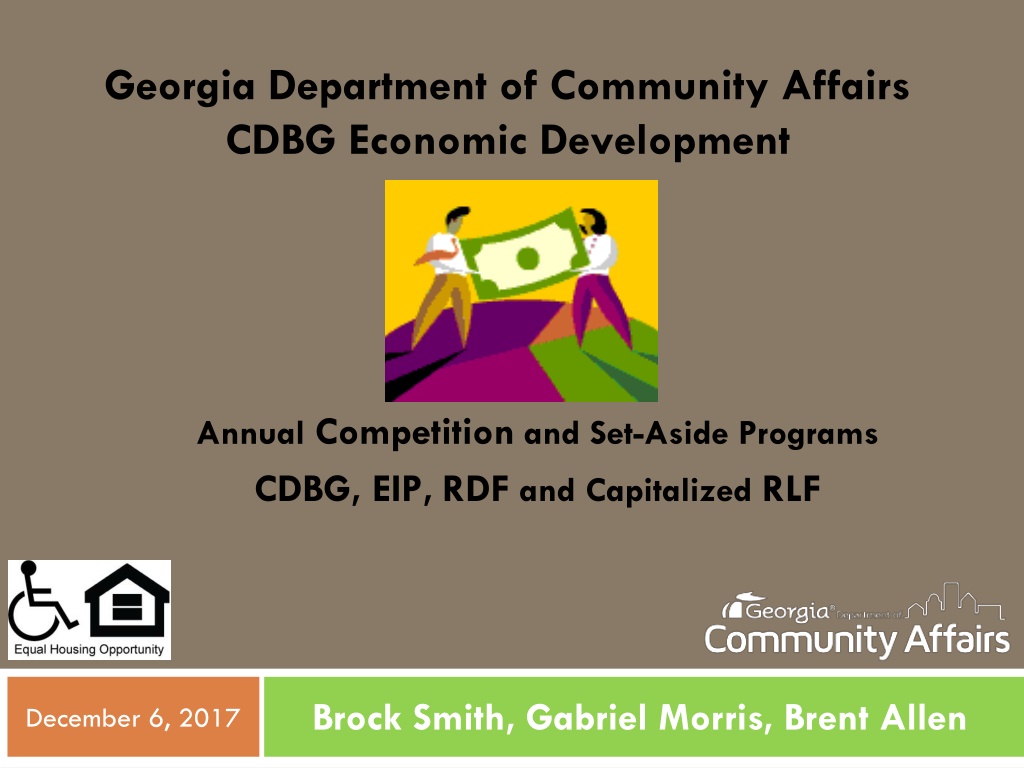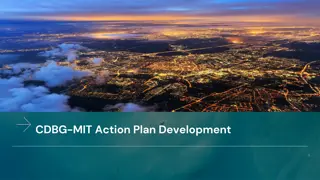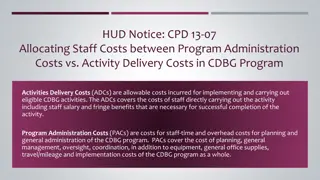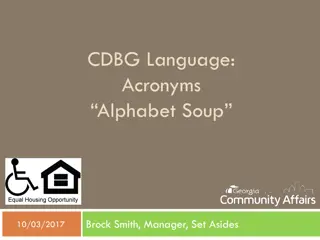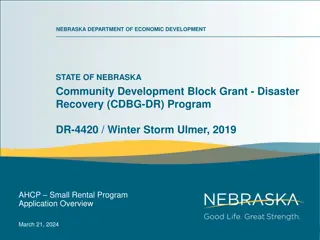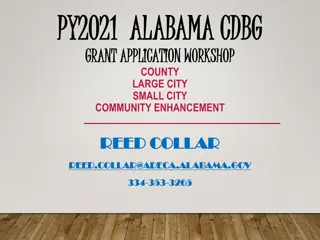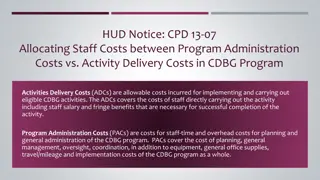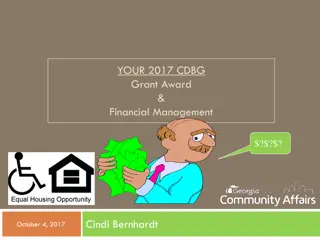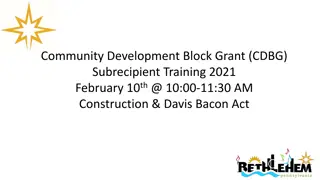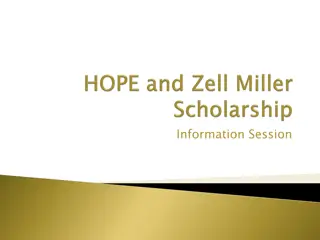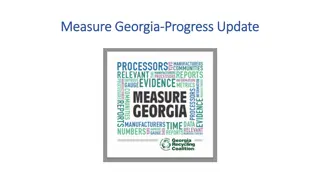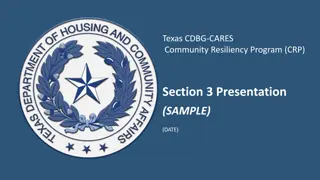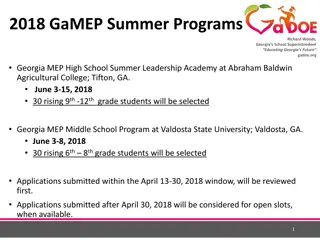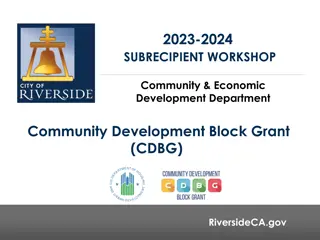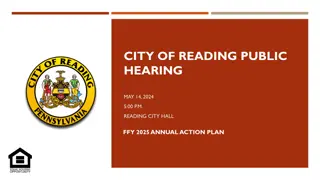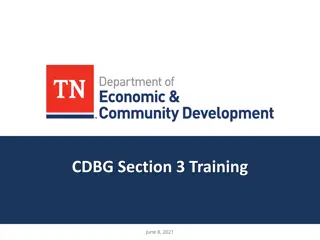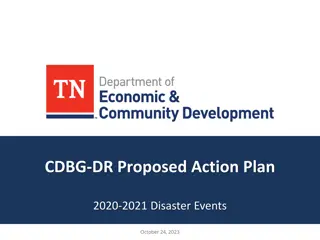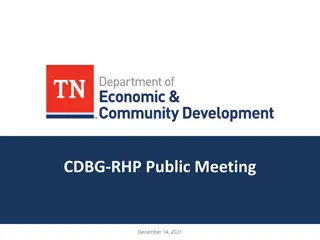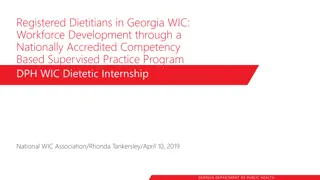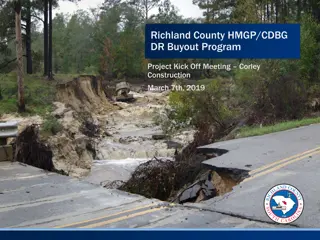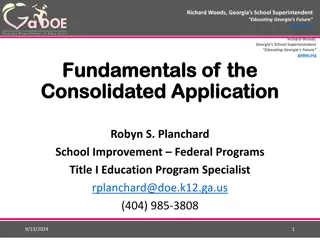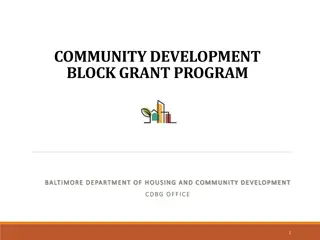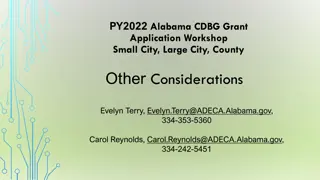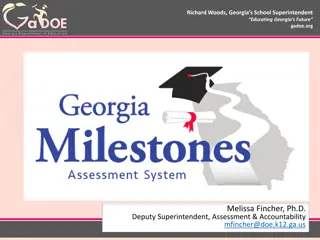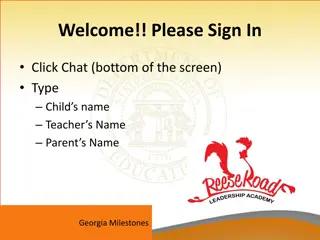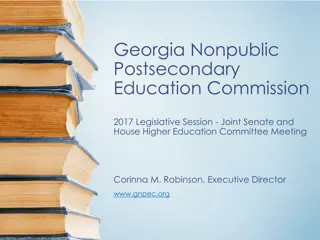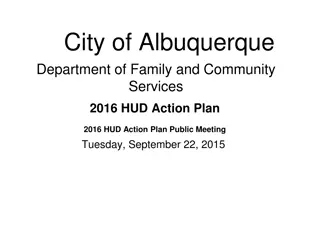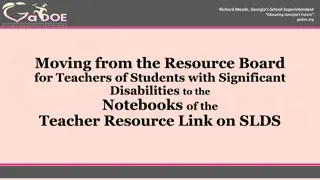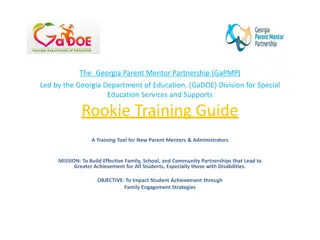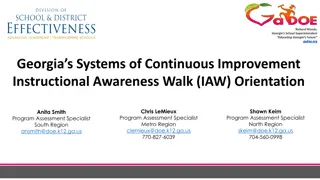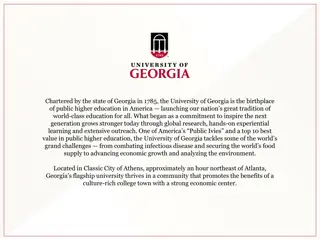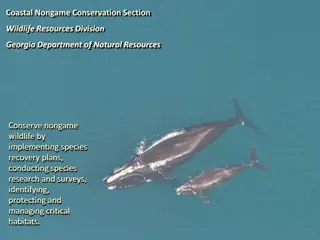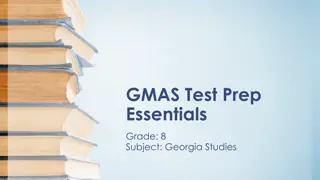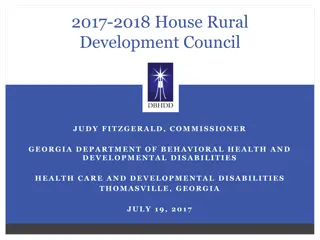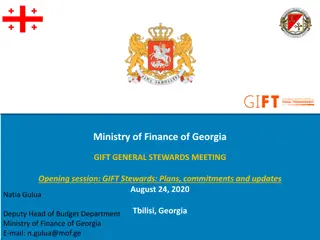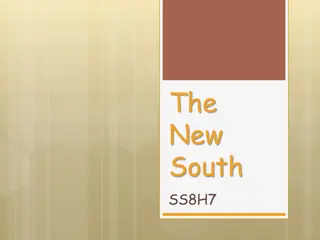Georgia Department of Community Affairs CDBG Economic Development Programs Overview
Georgia Department of Community Affairs manages various CDBG Economic Development Programs including Employment Incentive Program, Redevelopment Fund, and Set-Asides. These programs aim to support economic growth, job creation, and community revitalization in the state. Local governments can access funding and resources for activities that align with national objectives. The programs offer grants, loans, and other forms of assistance to promote economic development and address community needs.
Download Presentation

Please find below an Image/Link to download the presentation.
The content on the website is provided AS IS for your information and personal use only. It may not be sold, licensed, or shared on other websites without obtaining consent from the author. Download presentation by click this link. If you encounter any issues during the download, it is possible that the publisher has removed the file from their server.
E N D
Presentation Transcript
Georgia Department of Community Affairs CDBG Economic Development Annual Competition and Set-Aside Programs CDBG, EIP,RDF and Capitalized RLF Brock Smith, Gabriel Morris, Brent Allen December 6, 2017
Brock Smith, Manager CDBG Set-Asides Gabe Morris, Program Manager (EIP/RDF/ITAD) Brent Allen, RLF Program Manager Brock Smith December 6, 2017
Employment Incentive Program (EIP) and Redevelopment Fund (RDF) Threshold Based Competition Grants Brock Smith December 6, 2017
Set-Asides Overview Local governments can implement a broad range of activities as long as they further the National Objectives of the Act. Three National Objectives are: Majority benefit to low- and moderate-income persons through services and job creation; Prevention or elimination of slum and blight; Immediate Threat & Danger.
Available Funding: Georgia CDBG Funds from U.S. Housing and Urban Development (HUD) HUD $36,909,599 Authorization EIP $8.0 million set-aside RDF $1.5 million set-aside Immediate Threat $350,000 set-aside
Features of Economic Development Programs Maximum Grant Amount Primary Purpose $750,000 EIP - Expand employment opportunities for L/M income people RDF Eliminate Slum and Blight At least 51% of jobs created and/or retained Low/Moderate Income Benefit Eligible Uses Public facilities, infrastructure, business loans, elimination of Slum and Blight
Four Routes to ED with CDBG 1. Annual Competition CDBG-ED application Employment Incentive Program Redevelopment Fund Program Local Revolving Loan Fund (generated by CDBG-ED, EIP or RDF loans) 2. 3. 4.
Organizational Processes Potential Project Initial Project Assessments (EIP & RDF) Market Successful Concepts Local Community & Economic Development Needs Application Development & Submission Monitor & Audit Manage Projects Review & Underwrite Application Award / Denial Final Structure of Assistance
What exactly is this IPA? Initial Project Assessment (DCA) The Who, What, Why, When and Where of a Project; Determines and Preserves Eligibility of activities and costs; Enables Pre-Agreement Cost Approval (PACA) which is especially important for federal funds; Ensures all available funding sources are considered; and Provides an idea how competitive your project might be.
Process - What happens after I submit an IPA? PACA Initial Project Assessment EIP/RDF Provides guidance for application development Application Development Completeness Letter Completeness letters help identify shortcomings in the application Application Submission and Completeness Check Since EIP and RDF funding is threshold-based , the completeness letter allows for Technical Assistance to get applications to funding range.
Rating and Selection Criteria: EIP 300 Point Threshold Demographics 120 maximum points Determined by County level Census Data Feasibility 110 maximum points 27.5 points per level Impact 110 maximum points 27.5 points per level Strategy 110 maximum points 27.5 points per level RDF 375 Point Threshold Demographics 120 maximum points Determined by County level Census Data Feasibility 210 maximum points 52.5 points per level Strategy/Innovation 240 maximum points 60 points per level Leverage of Additional Resources 30 maximum points 10 points per level
EIP GRANT: PUBLIC INFRASTRUCTURE Gabriel Morris, Program Manager Gabriel Morris, Program Manager December 6, 2017
EIP Grant Program Eligible Activities Ineligible Activities Public Facilities Public Infrastructure Acquisition, Construction, and/or Rehabilitation of: Water; Sewer; Roads; Storm water drainage; Rail Spurs; Other. Working Capital Refinancing Speculative Projects Capacity Building General Conduct of Government Project Not Meeting Federal Guidelines Using Federal Funds to relocate businesses (Piracy - There are Restrictions)
EIP Infrastructure Grants Financial Considerations Include an Assessment of: Infrastructure Fund Capacity Analysis (IFCA) Examine financial capacity of local government Calculate operating and coverage ratios Revolving Loan Fund Capacity
EIP GRANT: LOAN TO PRIVATE FOR-PROFIT BUSINESS Gabriel Morris, Program Manager Gabriel Morris, Program Manager December 6, 2017
EIP Direct Loan Program Eligible Activities Ineligible Activities Acquisition of land and buildings New construction Renovation to existing buildings Acquisition of M&E Limited soft costs* Working capital Capacity building Refinancing Inventory/receivable financing Speculative real estate development Relocation costs Office equipment, small tools, supplies General conduct of government * Costs directly related to the fixed asset expenditure. Examples include: architectural/engineering costs; installation costs for machinery; and financing costs for bank loans.
EIP Direct Loan Program Loan Terms Up to 15 years for financed real property; Up to 7.5 years for financed personal property; The interest rate is fixed at or below market rates. Security/Collateral 1st or shared 1st priority mortgage and/or lien position on project costs/uses financed; Personal guaranties from owners (>20% ownership); Corporate guaranties from related companies. Repayment EIP Loan repayments must capitalize or be placed into a local Revolving Loan Fund (RLF).
EIP Loan Disbursement LOAN TO SUB-RECIPIENT BUSINESS GRANT TO APPLICANT LOAN TO LOCAL DEVELOPMENT AUTHORITY Loan Disbursement Disbursement agreement included in the EIP loan agreement. The Borrower s other public and/or private financing will be disbursed on a pro-rata basis with the EIP loan proceeds.
REDEVELOPMENT FUND PROGRAM (RDF) Gabriel Morris, Program Manager Gabriel Morris, Program Manager December 6, 2017
Overview of the RDF Program Encourage communities with blighted properties to focus on long-term community development. Projects must demonstrate the following: Resolution of Spot/Area Basis Blight; Long-term planning and development efforts of the community; Significant impact on the overall project; Strong community commitment; Ready to Proceed; and Completed within 24 months.
Elimination of Slum and Blight Spot Basis vs Area Basis Spot Basis Spot basis activities are limited to the extent necessary to eliminate specific conditions detrimental to the public health and safety. Area Basis Area basis activities are delineated by a unit of local government, meets a definition of a blighted, deteriorated, deteriorating, or slum area under State of Local law.
Common Issues And Solutions Brock Smith & Gabriel Morris December 6, 2017
CDBG ED Applications Timeline Awareness Businesses don t always consider the time for completing various federal requirements. Typically, local governments contract with an administrator to ensure timelines are followed. Typical timeline issues include: Environmental 90 days needed (Tribal, HPD, Notices) Design review can be several months (EPD, Railroad) Acquisition depends on the amount of acquisition needed Submitting an application too late or too early is not advisable.
CDBG ED Applications Engage Pertinent Partners Local Government Other federal/state programs Development Authority Owner Engineer/Architect Railroad (if applicable) Business Contact Operator (if applicable) Grant Writer/Administrator Occupant (if applicable) DCA Service Representative
CDBG ED Applications Paint the Whole Picture Provide ALL pertinent information regarding a potential project. All financing components must be identified and listed in the budget forms and application narrative (DCA-5). Include a current PER or PAR (within the last 6 to 8 months). For RDF, indicate occupants for redeveloped facilities (if known). Source and Use/Budget Forms.
CDBG ED Applications Required Agreements Cooperating agreement for joint applications; Submit Draft or Executed Agreements with application: MOU; Intergovernmental Agreement(s); Lease Agreements; and Deeds. RLF Policies and Procedures, if requesting comments on draft; and Loan Documents DCA can provide draft documents if loan project will require funds available at closing (not a dry closing ). Letter of Credit/Surety Instrument.
CDBG ED Applications Local Government Compliance Local government audits for previous 3 years; https://ted.cviog.uga.edu/financial-documents/ Comprehensive Plan/SDS/Finance Survey/Authority Registration; and Department of Audits and Accounts Compliance: Out of Compliance = Ineligible for State Funds!
CDBG ED Applications/Awards Communicate with DCA Staff When questions or issues arise: Guidance from Office Staff or Field Staff; Change Orders or Increase/Decrease in Scope: Keep DCA informed; 10% Change in size or cost requires a Grant Amendment. Questions or Comments on Forms. Talk to DCA more than you talk to your Mom Image result for telephone
CDBG ED Awards Contracts/Agreements Economic Development & Construction Agreement (ED&C) Do Not Date! Ensure contractor clearance is granted by DCA before work is initiated. Review Certified Payrolls and check Davis-Bacon Wage Rates for any additional classifications. The state public procurement process must be followed for any contract exceeding $100,000. Keep DCA staff aware of any changes to the construction timeline, especially if it may lead to a need for requesting an extension.
CDBG ED Awards Drawdowns Drawdowns for ED projects are conducted on a Pro-Rata basis; All invoicing and any voided checks must be included with draw requests; Update the signature card if there has been a change in local government officials; Drawdowns are generally processed on Tuesdays and Thursdays; Drawdowns will be deposited in the local account within 7- 10 business days after being processed.
CDBG ED Awards Closeout For EIP, provide a letter from the local government and the Company indicating all commitments were met. The final Quarterly Report should display the cumulative number of jobs created and the Accomplishments tab should reflect all of the information presented on the Employer Summary form. DO NOT LET THE GRANT PERIOD LAPSE.
LOCAL REVOLVING LOAN FUND (RLF) Brent Allen, Program Manager Brent Allen, RLF Program Manager December 6, 2017
Local Revolving Loan Funds EIP/RDF loan repayments capitalize local RLF loan. The repayments (including interest), and bank account interest retain federal identity. This is considered program income. RLFs may be used for local CDBG eligible economic development needs. Opportunities available to partner with local banks to finance eligible activities (same as EIP) that create employment for LMI persons. 50/40/10 Rule: Project funded with 50% RLF, 40% local bank, and 10% private funding.
Local Revolving Loan Funds 67 active RLF s throughout Georgia, with: $36.7 million in RLF assets $15.6 million in cash $21.1 million in loan receivables $1.3 million cash returned to DCA over the past year for non-compliance or closure (7) of RLFs. Encourage Local RLF s to use RLF funds as a funding gap for large projects may request one-time waiver to DCA, if necessary.
CONTACTS Brock Smith December 6, 2017
Community Services Representatives Region 1 Patrick Vickers Region 2 Kathy Papa Region 3 John VanBrunt Region 4 Corinne Thornton (404) 695-2093 (770) 362-7078 (706) 825-1356 (706) 340-6461 Region 5 Beth Eavenson Region 6 Tonya Mole Region 7 Tina Hutcheson Region 8 Casey Beane (404) 387-6977 (404) 852-6876 (478) 278-9434 (404) 227-2860 Region 9 Lynn Ashcraft Region 10 Gina Webb Region 11 Kelly Lane Region 12 Jennifer Fordham (478) 484-0321 (404) 387-1429 (404) 227-3619 (912) 531-1746 Saralyn Stafford Division Director (404) 679-3166 saralyn.stafford@dca.ga.gov Corinne Thornton Office Director (706) 340-6461 corinne.thornton@dca.ga.gov
Program Manager Contacts: Brock Smith Manager, CDBG Set-Asides (404) 679-1744 brock.smith@dca.ga.gov Gabe Morris EIP/RDF/ITAD (404) 679-3174 gabriel.morris@dca.ga.gov Brent Allen RLF Program Manager (404) 217-0733 brent.allen@dca.ga.gov
